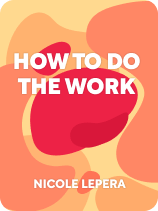

This article is an excerpt from the Shortform book guide to "How to Do the Work" by Nicole LePera. Shortform has the world's best summaries and analyses of books you should be reading.
Like this article? Sign up for a free trial here.
Want to know how to change your beliefs? What are the benefits of adopting new beliefs? Which beliefs about yourself are harmful?
Bestselling author Nicole LePera explored how painful childhood experiences led you to develop the defensive beliefs that form the foundation of all your self-sabotaging patterns. LePera claims that childhood beliefs take root in your mind and continue to influence all your patterns as an adult.
Keep reading to learn how to change your self-destructive beliefs into positive ones, according to LePera.
Change Your Beliefs: How to Feel Happier
Learning how to change your beliefs means you also need to learn the specific beliefs that fuel unwanted behavior patterns. Create new beliefs to support the patterns you want to adopt. Since behaviors are a natural extension of beliefs, it follows that new beliefs will inevitably lead to new behaviors (your behaviors always reflect your beliefs about yourself). Therefore, LePera argues that acknowledging and changing your beliefs will train your subconscious mind how to practice healthier behaviors.
| Your Subconscious Mind Protects Your Self-Perception Psychologist Prescott Lecky’s self-consistency theory sheds light on how it’s difficult to change your beliefs because your subconscious mind resists changing your default patterns. He argues that your subconscious mind is programmed to protect your beliefs about yourself and to align your behaviors with these beliefs. This means that: 1) Your automatic patterns always reflect what you believe about yourself. 2) Your subconscious mind resists adopting patterns that contradict your beliefs about yourself. Further, your subconscious mind creates resistance even when you attempt to make a positive change, such as quitting smoking. This is because your subconscious mind doesn’t judge whether your beliefs are “good” or “bad”—it only seeks to protect them. Depending on how big the change to your beliefs is, your subconscious mind will feel more or less threatened. The bigger the change, the more psychological and physical discomfort it creates to resist this change. |
LePera suggests that you follow a three-step process to change your beliefs by describing how to create new beliefs:
- Choose a belief you think is holding you back from the life you want to live. For example, “To feel safe and loved, I must appear perfect at all times.”
- Write down what you want to believe. For example, your new belief might be: “I am lovable even when I make mistakes.”
- Turn your new belief into a mantra and repeat it multiple times a day.
(Shortform note: In addition to changing your beliefs, mantras also teach you how to think more positively. A recent study into the effect of mantras confirms that repeating a single word or short phrase quiets your internal critic. Researchers used functional magnetic resonance imaging to examine the brain blood flow patterns of people who silently repeated a mantra. The imaging showed a reduction of activity across the brain, primarily in the area of the brain that gives rise to internal thoughts—this is the area that generates self-critical and negative thoughts.)
| Other Perspectives on How to Change Your Beliefs According to LePera, changing your beliefs will naturally lead to more positive behaviors. Similarly, lots of self-help authors claim that you just need to improve your thoughts to improve your life. For example, Louise Hay (You Can Heal Your Life) argues that you just need to “affirm” what you want to make it come true: Change the statement “I must be perfect” to “I’m perfect as I am” and repeat this multiple times a day. Eventually, you’ll come to believe this thought and your behavior will align with your new beliefs. However, Maxwell Maltz (Psycho-Cybernetics) argues that affirmations are not enough to change your default patterns—he believes that your mind will automatically reject thoughts that don’t align with your established beliefs. He claims that the only way to change your beliefs is to regularly use your imagination to visualize and feel yourself behaving how you want be—this is because your nervous system operates according to how you feel, not how you think. According to Maltz, this practice will train your mind to become more comfortable with the feeling of who you want to be, and it’s the only way to overcome old and unproductive beliefs. Therefore, as you repeat your mantra, imagine yourself as someone who already practices your chosen pattern, and attempt to feel what it’s like to live the life you want. |

———End of Preview———
Like what you just read? Read the rest of the world's best book summary and analysis of Nicole LePera's "How to Do the Work" at Shortform.
Here's what you'll find in our full How to Do the Work summary:
- How childhood conditioning impacts your mental and physical health
- How to develop positive patterns that improve your well-being
- Tools to feel happier, healthier, and more in control of your life






